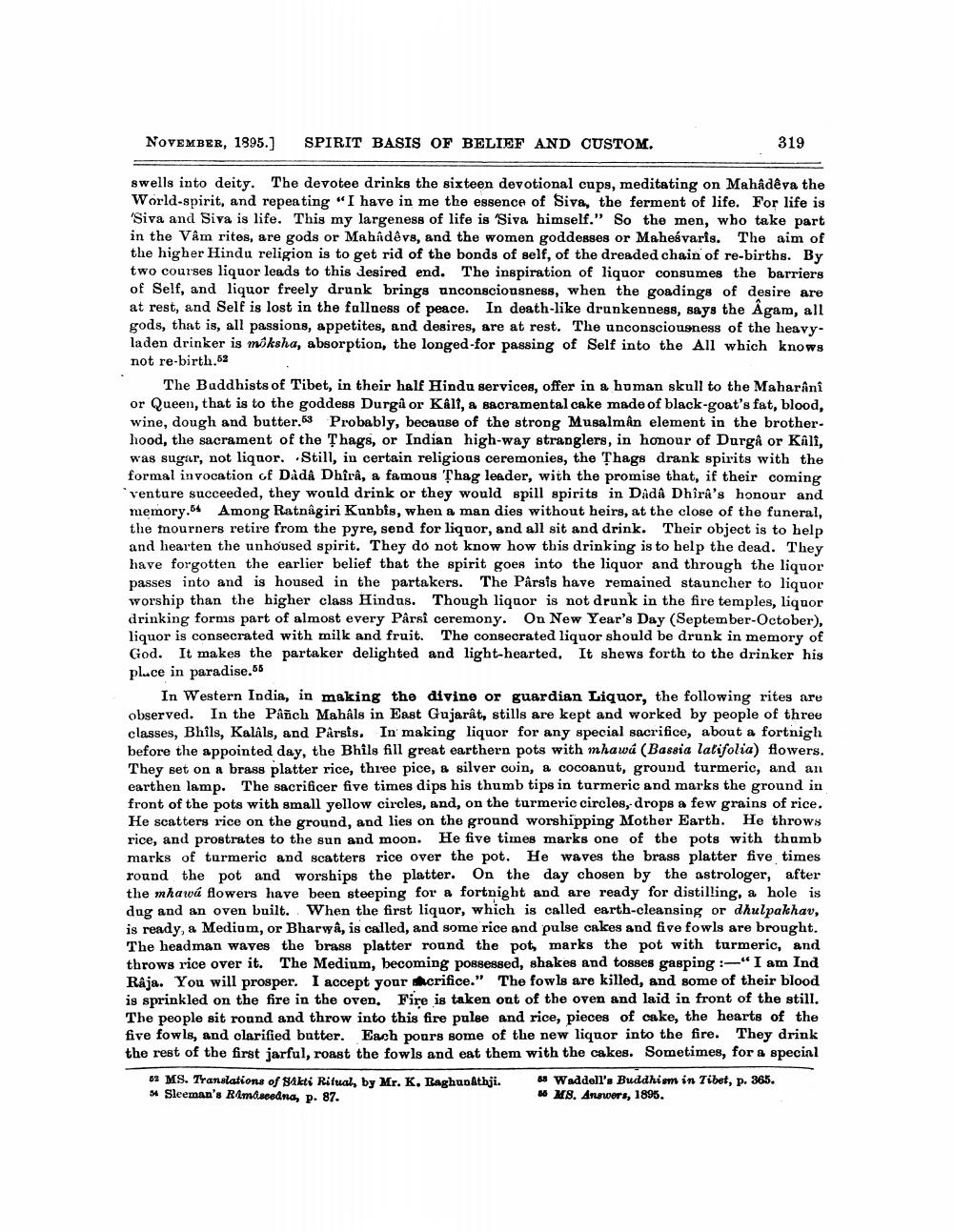________________
NOVEMBER, 1895.] SPIRIT BASIS OF BELIEF AND CUSTOM.
swells into deity. The devotee drinks the sixteen devotional cups, meditating on Mahâdêva the World-spirit, and repeating "I have in me the essence of Siva, the ferment of life. For life is 'Siva and Siva is life. This my largeness of life is 'Siva himself." So the men, who take part in the Vâm rites, are gods or Mahîdêvs, and the women goddesses or Maheśvaris. The aim of the higher Hindu religion is to get rid of the bonds of self, of the dreaded chain of re-births. By two courses liquor leads to this desired end. The inspiration of liquor consumes the barriers of Self, and liquor freely drunk brings unconsciousness, when the goadings of desire are at rest, and Self is lost in the fullness of peace. In death-like drunkenness, says the Âgam, all gods, that is, all passions, appetites, and desires, are at rest. The unconsciousness of the heavyladen drinker is môksha, absorption, the longed-for passing of Self into the All which knows not re-birth.52
The Buddhists of Tibet, in their half Hindu services, offer in a human skull to the Maharânî or Queen, that is to the goddess Durga or Kâlî, a sacramental cake made of black-goat's fat, blood, wine, dough and butter.53 Probably, because of the strong Musalmân element in the brotherhood, the sacrament of the Thags, or Indian high-way stranglers, in honour of Durga or Kâlî, was sugar, not liquor. Still, in certain religious ceremonies, the Thags drank spirits with the formal invocation of Dadâ Dhîrâ, a famous Thag leader, with the promise that, if their coming `venture succeeded, they would drink or they would spill spirits in Dâdâ Dhîrâ's honour and memory.54 Among Ratnagiri Kunbis, when a man dies without heirs, at the close of the funeral, the mourners retire from the pyre, send for liquor, and all sit and drink. Their object is to help and hearten the unhoused spirit. They do not know how this drinking is to help the dead. They have forgotten the earlier belief that the spirit goes into the liquor and through the liquor passes into and is housed in the partakers. The Pârsis have remained stauncher to liquor worship than the higher class Hindus. Though liquor is not drunk in the fire temples, liquor drinking forms part of almost every Pârsi ceremony. On New Year's Day (September-October), liquor is consecrated with milk and fruit. The consecrated liquor should be drunk in memory of God. It makes the partaker delighted and light-hearted. It shews forth to the drinker his place in paradise.55
319
In Western India, in making the divine or guardian Liquor, the following rites are observed. In the Pâñch Mahâls in East Gujarât, stills are kept and worked by people of three classes, Bhils, Kalâls, and Pârsis. In making liquor for any special sacrifice, about a fortnigh before the appointed day, the Bhils fill great earthern pots with mhawa (Bassia latifolia) flowers. They set on a brass platter rice, three pice, a silver coin, a cocoanut, ground turmeric, and an earthen lamp. The sacrificer five times dips his thumb tips in turmeric and marks the ground in front of the pots with small yellow circles, and, on the turmeric circles, drops a few grains of rice. He scatters rice on the ground, and lies on the ground worshipping Mother Earth. He throws rice, and prostrates to the sun and moon. He five times marks one of the pots with thumb marks of turmeric and scatters rice over the pot. He waves the brass platter five times round the pot and worships the platter. On the day chosen by the astrologer, after the mhawú flowers have been steeping for a fortnight and are ready for distilling, a hole is dug and an oven built. When the first liquor, which is called earth-cleansing or dhulpakhav, is ready, a Medium, or Bharwâ, is called, and some rice and pulse cakes and five fowls are brought. The headman waves the brass platter round the pot, marks the pot with turmeric, and throws rice over it. The Medium, becoming possessed, shakes and tosses gasping :-"I am Ind Raja. You will prosper. I accept your crifice." The fowls are killed, and some of their blood is sprinkled on the fire in the oven. Fire is taken out of the oven and laid in front of the still. The people sit round and throw into this fire pulse and rice, pieces of cake, the hearts of the five fowls, and clarified butter. Each pours some of the new liquor into the fire. They drink the rest of the first jarful, roast the fowls and eat them with the cakes. Sometimes, for a special
52 MS. Translations of Sakti Ritual, by Mr. K. Raghunathji. 54 Sleeman's R4mâseedna, p. 87.
63 Waddell's Buddhism in Tibet, p. 365. 65 MS. Answers, 1895.




